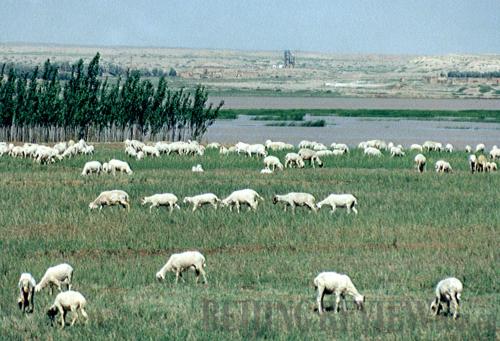|
From 2000 to 2008, 60 billion yuan ($8.78 billion) was allocated to reduce the region's impoverished population, cutting the number from 57.3 million to 26.5 million. Per-capita annual net income of rural residents increased 113.3 percent, reaching 3,481 yuan ($510) in 2008.
Infrastructure improvements
Movie crews looking to film horse or camel teams in China's west ended up shooting footage in tourist sites since such methods are no longer the dominant means of transportation in the western region—a testament to the transportation improvements made in west China.
Villages in remote areas are becoming more accessible; earth roads have been expanded and covered with asphalt; and large and medium-sized cities are linked to a vast railway or expressway network. Some areas even have their own airports.
 |
|
GREEN AND GROWING: Sheep graze in a field in Shizhuishan, Ningxia Hui Autonomous Region. Efforts to reclaim forests and pastures from farmland have paid off in recent years (ZHANG BO/CFP) |
"It was not always this convenient," said Bao An, a 34-year-old villager in Longlong Village, Yunnan Province.
Growing tea trees has been the primary source of income for Bao and his family for some years. Bao remembers the days when horses were used to transport tea harvests out of the mountains to the county seat located more than 30 km away. But a few years ago, the village was linked to the outside world through a series of roads. Roads in Bao's village were also paved with cement.
Accelerating infrastructure construction is the prime task of the Western Development endeavor, according to the strategy's drafter and supervisor, the Western Development Office under the National Development and Reform Commission (NDRC). In the past 10 years, the Central Government has increased its support to various construction projects in the region. From 2000 to 2008, the Central Government invested 1.7 trillion yuan ($249 billion) to improve local infrastructure facilities.
NDRC statistics show more than 888,000 km of highways were constructed in this region between 2000 and 2008, of which 13,927 km were expressways. By the end of 2008, west China had boasted a network of highways totaling 1.42 million km, accounting for 38.1 percent of the country's total, while the network of expressways, standing at 16,456 km, accounted for 23.2 percent of the country's total.
In terms of railway construction, more than 8,000 km of rails were laid between 2000 and 2008, bringing the region's total rail network length to 29,400 km. The launch of the Qinghai-Tibet Railway, an engineering marvel, ended the history of Tibet being the only provincial-level region without railway service in China. The Qinghai-Tibet Railway had played an integral part in the economic and social development of Tibet, transporting more than 3.53 million passengers and more than 2.8 million tons of goods by the end of 2008.
West China's airport network has also been expanded—capacities of 42 airports were increased and 21 new branch airports were constructed to handle air traffic. By the end of 2008, the western region had 79 airports for civil aviation, accounting for 49.4 percent of the country's total.
Protecting minority cultures
Zhou Xiaoting and Zhou Xiaole are two sisters of the Jinuo minority group from the Jinuo Mountain in Yunnan. Zhou Xiaoting, 18, recently graduated from a vocational school where she learned some basic computer skills. Zhou Xiaole, 16, was admitted to the same school this summer.
The sisters' family lives with dozens of households in a small mountain village, with houses typical of the Jinuo minority—an all-wooden structure with two floors.
The sisters share a computer with Internet access and an exercise machine in their second floor bedroom. They also have a TV with a satellite receiver in their living room that gives them access to more than 50 channels. Like city girls of their age, the Zhou sisters are fans of pop singers from Hong Kong, Taiwan and across the mainland.
Tuition for the vocational school is covered by the government, and the sisters only need 200-300 yuan ($29.3-43.9) a month for extra expenses. Needless to say, dropout rates due to financial problems are non-existent, the elder Zhou sister said.
| 